The Archaeological Site of Delphi is situated in central Greece, 180 km from Athens. Delphi is situated high on the slopes of Mount Parnassus, overlooking the Gulf of Corinth. Delphi is one of the most important ancient sanctuaries. In ancient times, Delphi was considered the centre of the known world, where heaven and earth met. Delphi was the place on earth where man was closest to the gods. Delphi is known as the centre for the worship of the god Apollo, the son of Zeus. The centre of Delphi is the Temple of Apollo. The temple was the home of the Oracle of Delphi, the Pythia. The Pythia was a spiritual experience whereby the spirit of Apollo was asked for advice. The Oracle of Delphi was the most famous and powerful oracle of the Ancient World. The Sacred Way leads to the Temple of Apollo (6th century BC), the Stoa of the Athenians, the Treasury of the Athenians, the Theatre and Stadium of Delphi. The Tholos or Marmaria of Delphi in the Sanctuary of Athena Pronaia, and the Gymnasium of Delphi are situated at the foot of Mount Parnassus. The Tholos of Delphi was built in a combination of the Doric and Corinthian styles, inspired by the Temple of Apollo Epicurius at Bassae. The Castalian Spring is a sacred spring where people washed themselves before consulting the Oracle of Delphi. The Castalian Spring lies in the ravine of the Phaedriades. The cult of the Pythia was forbidden in 391 AD by the Emporor Theodosius I, also known as Theodosius the Great, a Christian emperor of the Roman Empire, to which Greece was then a province. There are numerous ancient sanctuaries in Greece, the most important and well-known are situated in Athens, on the island of Delos, in Delphi, at Epidaurus and Olympia. Archaeological excavations at Ancient Delphi started in 1892, after the inhabitants of the village of Kastri, which was built on the ruins of Ancient Delphi, were relocated to the modern town of Delphi. The Delphi Archaeological Museum houses artifacts found during excavations at the Archaeological Site of Delphi such as the Sphinx of Naxos, the statues of the brothers Kleobis and Biton, the Heniokhos, known as the statue of the Charioteer of Delphi. The Archaeological Site of Delphi gained status as a UNESCO World Heritage in 1987. Photo Art: Mystic Delphi
www.werelderfgoedfotos.nl © Copyright World Heritage Photos
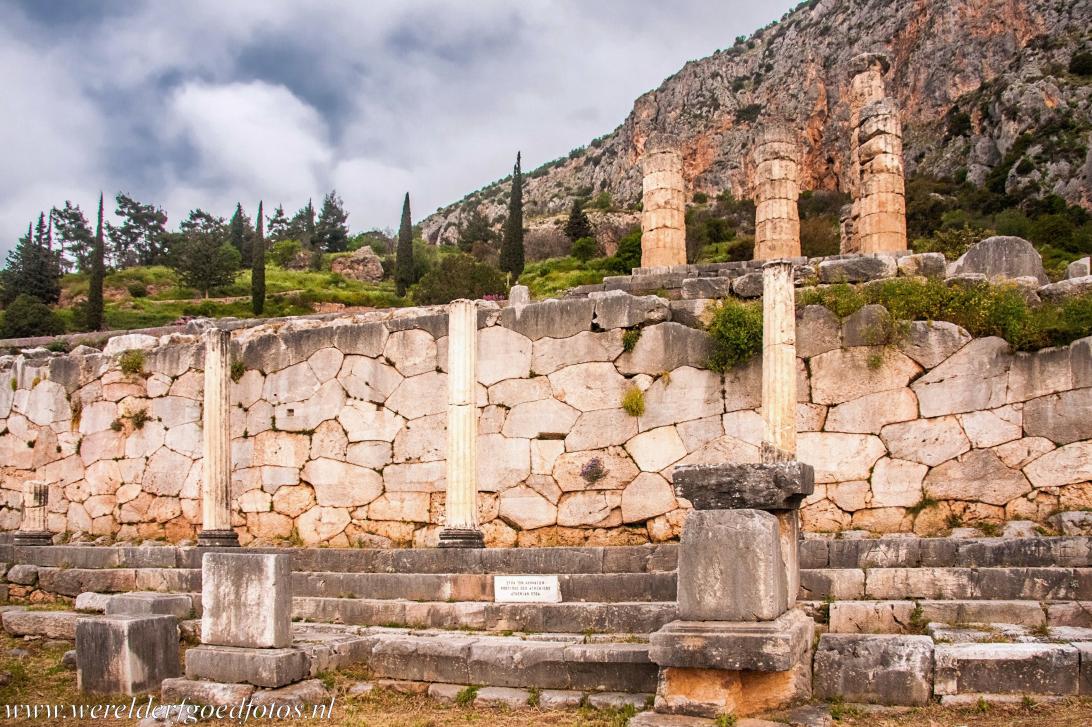
Archaeological Site of Delphi: The Stoa of the Athenians in Delphi is located on the Sacred Way to the Temple of Apollo. The Stoa of the Athenians was built in 478 BC. The stoa was built in the Ionic style. Ancient Delphi is located in lower central in Greece, 180 km from Athens. Delphi lies high on the slopes of Mount Parnassus, it is overlooking the Gulf of Corinth. The Archaeological Site of Delphi was inscribed on the UNESCO World Heritage List in 1987.

Archaeological Site of Delphi: The Stoa of the Athenians in Delphi is located on the Sacred Way to the Temple of Apollo. The Stoa of the Athenians was built in 478 BC. The stoa was built in the Ionic style. Ancient Delphi is located in lower central in Greece, 180 km from Athens. Delphi lies high on the slopes of Mount Parnassus, it is overlooking the Gulf of Corinth. The Archaeological Site of Delphi was inscribed on the UNESCO World Heritage List in 1987.
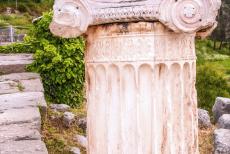
Archaeological Site of Delphi: The remaining part of an Ionic column at the Sanctuary of Delphi. The Sanctuary of Delphi is known as the centre of worship for the god Apollo, the son of Zeus. The Sacred Way is leading from the gateway up to the top of Mount Parnassus, the way is lined with monuments such as the rock of the Oracle, the Temple of Apollo, the Stoa of the Athenians, the Treasury of the Athenians, a theatre and a stadium.
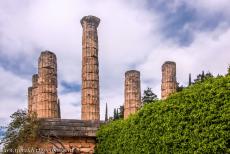
Archaeological Site of Delphi: The rock of the Oracle of Delphi, in the background the Temple of Apollo. The Oracle of Delphi was female and also known as the Pythia of Delphi. The oracle was a spiritual experience whereby the spirit of Apollo was asked for advice. The oracle stood upon this rock while pronouncing the prophecies, a priest translated them to the people. The Temple of Apollo was built in the 4th century BC on the remains of in earlier temple.
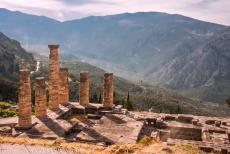
Archaeological Site of Delphi: The Temple of Apollo was dedicated to the god Apollo and was the home of the Pythia, the Oracle of Delphi. In 390 AD, the temple was destroyed on the orders of the Christian Emperor Theodosius I, the statues and artworks were also destroyed in the name of Christianity. In ancient times, Delphi was considered the navel, omphalos, of the world, where Heaven and Earth met. Delphi was the place on Earth where man was closest to the gods.
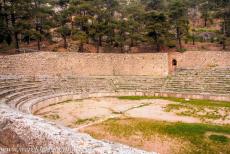
Archaeological Site of Delphi: The Stadium of Delphi was built in the 5th century BC, the stadium was remodelled several times. The stadium is situated on top of Mount Parnassus. The present Stadium of Delphi was built in the second century BC when Herodes Atticus financed the arched entrance and the stone seating. The stadium could seat approx. 6,500 spectators. The stadium track is 177 metres long and 25.5 metres wide.
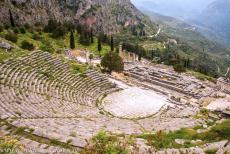
Archaeological Site of Delphi: The Theatre of Delphi viewed from above, the theatre was built on the slopes of Mount Parnassus in the 4th century BC. The theatre has 35 stone rows and could accommodate up to 5,000 spectators. The Theatre of Delphi is located on the Sacred Way and it overlooks the Pleistos Valley. The Tholos of the Sanctuary of Athena Pronaia is situated at the foot of Mount Parnassus and is clearly visible from the Theatre of Delphi.
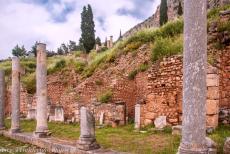
Archaeological Site of Delphi: The Stoa of the Athenians was built by the Athenians after their naval victory over the Persians in 478 BC. There are several treasuries built along the Sacred Way in Delphi, they were built to commemorate a victory or to thank the Oracle of Delphi for her advice. The treasuries held the votive offerings made to Apollo, the Greek god of the sun and light. The cult of the Oracle of Delphi was forbidden in 391 AD by Emperor Theodosius I
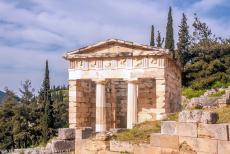
Archaeological Site of Delphi: The Treasury of the Athenians was built somewhere between 510 and 480BC. The treasury was erected as a votive temple. The treasury was built of marble from the island of Paros, it was presumably built after the Athenian victory over the Persians at the Battle of Marathon in 490 BC. The frieze is a copy, the original is on display in the Archaeological Museum Delphi. The Treasury of the Athenians is the most complete building at Ancient Delphi.
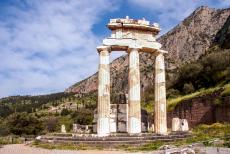
Archaeological Site of Delphi: The Marmaria, the Tholos of the Sanctuary of Athena Pronaia. The tholos at Delphi was a circular building, erected between 380-360 BC. The purpose of the tholos is unknown. It consisted of twenty Doric columns and ten Corinthian columns, three of the Doric columns have been restored. The Tholos of the Sanctuary of Athena Pronaia is a masterpiece of classical architecture. The metopes were richly adorned with relief sculptures.
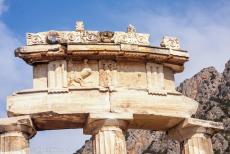
Archaeological Site of Delphi: The last remaining Doric frieze of the Tholos of Delphi, the tholos was an ancient circular building in the Sanctuary of Athena Pronaia at Delphi. The tholos is also known as the Marmaria of Delphi. The tholos is situated just outside the Sanctuary of Delphi in the valley of the Pleistos River, it is the most renowned structure of this ancient Greek religious sanctuary. The Archaeological Site of Delphi was declared a UNESCO World Heritage in 1987.
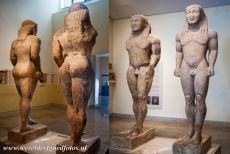
Delphi Archaeological Museum: The statues of the brothers Kleobis and Biton, also known as the Kouroi of Delphi. The twin statues come from Argos in the Peloponnese peninsula but were excavated at Delphi in 1893 and 1894 near the Treasury of the Athenians. The statues of Kleobis and Biton date from around 580 BC. The Delphi Archaeological Museum is one of the foremost museums in Greece, it is situated next to the Archaeological Site of Delphi.
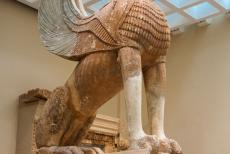
Delphi Archaeological Museum: The Sphinx of Naxos rests on an Ionic column, the statue dates approx. to 560 BC. The statue was erected at Delphi by the citizens from the Island of Naxos. In gratitude, the priests gave the citizens of Naxos the honour of priority in consulting the Oracle of Delphi. The Sphinx of Naxos has the head of a woman, the body and legs of a lion, the wings and chest of an eagle. The sphinx was made from Naxian marble, sourced from Naxos Island.
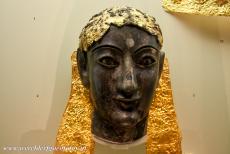
Delphi Archaeological Museum: This sculpted head of Apollo was made of ivory and gold. This sculpture of Apollo and the sculptures of Artemis and Leto were found in a pit along the Sacred Way at Delphi. The Delphi Archaeological Museum houses a collection of gold jewelry, found at the Archaeological Site of Delphi. The Delphi Archaeological Museum houses numerous artifacts that were found during excavations at the Archaeological Site of Delphi.
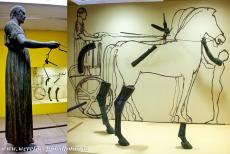
Delphi Archaeological Museum: The Charioteer of Delphi is also known as Heniokhos, the rein-holder. The Charioteer of Delphi dates from 470 BC. The statue is 1.80 metres tall. It was found at Delphi in 1896. The statue is one of the best known ancient Greek statues and one of the best preserved examples of classical bronze casts, the Charioteer of Delphi is on display in the Delphi Archaeological Museum, the museum is situated next to the Archaeological Site of Delphi.
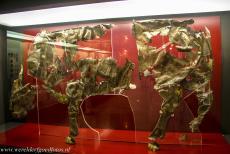
Archaeological Site of Delphi: The Silver Bull of Delphi is reconstructed from fragments of silver sheets found in the Temple of Apollo at the Archaeological Site of Delphi, the silver sheets were found damaged and crumbled. The Silver Bull of Delphi is the first large-scale statue all made from forged metal, the ears, horns and hooves are gilded. The statue was probably made in the 6th century BCE. The Silver Bull of Delphi is on display in the Delphi Archaeological Museum.
